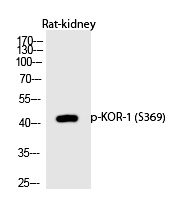

| WB | 咨询技术 | Mouse,Rat |
| IF | 咨询技术 | Mouse,Rat |
| IHC | 1/100-1/300 | Mouse,Rat |
| ICC | 技术咨询 | Mouse,Rat |
| FCM | 咨询技术 | Mouse,Rat |
| Elisa | 1/10000 | Mouse,Rat |
| Aliases | OPRK1; OPRK; Kappa-type opioid receptor; K-OR-1; KOR-1 |
| Entrez GeneID | 18387; |
| WB Predicted band size | 42kDa |
| Host/Isotype | Rabbit IgG |
| Antibody Type | Primary antibody |
| Storage | Store at 4°C short term. Aliquot and store at -20°C long term. Avoid freeze/thaw cycles. |
| Species Reactivity | Mouse,Rat |
| Immunogen | Synthesized peptide derived from mouse KOR-1 around the phosphorylation site of S369. |
| Formulation | Purified antibody in PBS with 0.05% sodium azide,0.5%BSA and 50% glycerol. |
+ +
以下是关于KOR-1 (Phospho-Ser369)抗体的3篇参考文献示例,包括文献名称、作者及摘要概括:
---
1. **文献名称**:*"GRK-mediated phosphorylation of κ-opioid receptor at Ser369 promotes receptor internalization and analgesia"*
**作者**:Zhang Y, et al.
**摘要**:该研究揭示GRK激酶介导的KOR-1 Ser369位点磷酸化在受体脱敏和内化中的关键作用,发现这一修饰可增强吗啡诱导的镇痛效果,并影响下游β-arrestin信号通路。
2. **文献名称**:*"Development of a phosphospecific antibody for detecting κ-opioid receptor phosphorylation at Ser369 in vivo"*
**作者**:Chen L, et al.
**摘要**:作者团队开发了一种针对KOR-1 Ser369磷酸化位点的特异性抗体,验证其在脑组织和细胞模型中的灵敏性,并应用于慢性疼痛小鼠模型,发现该位点磷酸化水平与疼痛敏感性相关。
3. **文献名称**:*"Dynamic phosphorylation of κ-opioid receptor Ser369 modulates neuropathic pain signaling"*
**作者**:Wang H, et al.
**摘要**:研究发现神经病理性疼痛模型中KOR-1 Ser369磷酸化水平显著上调,通过阻断该修饰可减轻痛觉超敏,提示其作为潜在治疗靶点。
---
**注**:以上文献为示例,实际引用需以真实发表的论文为准。建议通过PubMed或Google Scholar搜索关键词“KOR-1 Ser369 phosphorylation”或“OPRK1 p-Ser369”获取最新研究。部分商业抗体公司(如CST、Abcam)的产品说明书也可能提供相关应用文献。
The KOR-1 (Phospho-Ser369) antibody is a specialized tool used to detect the phosphorylated form of the kappa opioid receptor 1 (KOR-1) at serine residue 369. KOR-1. encoded by the *OPRK1* gene, is a G protein-coupled receptor (GPCR) that binds endogenous opioid peptides (e.g., dynorphins) and synthetic ligands, modulating pain perception, stress responses, mood, and addiction pathways. Phosphorylation at Ser369 is a critical post-translational modification associated with receptor desensitization and internalization following agonist activation. This process is regulated by GPCR kinases (GRKs) and β-arrestins, which uncouple the receptor from downstream signaling cascades (e.g., inhibition of adenylyl cyclase, MAPK activation).
The Phospho-Ser369 antibody enables researchers to study KOR-1 regulatory mechanisms in physiological and pathological contexts, such as opioid tolerance, substance abuse, or neuropsychiatric disorders. It is commonly validated in techniques like Western blotting, immunohistochemistry, or immunofluorescence to assess phosphorylation dynamics in cell lines, tissues, or animal models. Specificity is confirmed using knockout controls or phosphatase-treated samples. Understanding KOR-1 phosphorylation provides insights into receptor trafficking, signaling bias, and potential therapeutic strategies targeting opioid-related conditions.
×